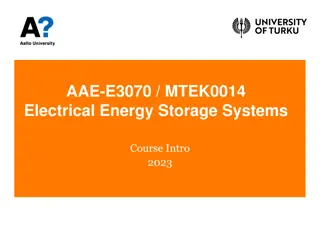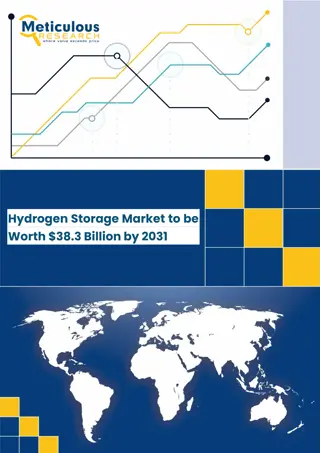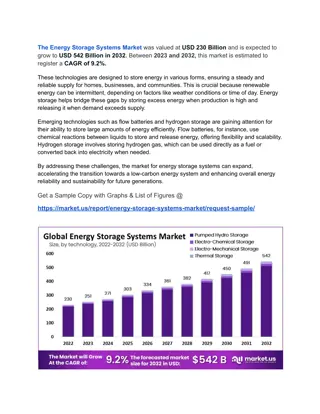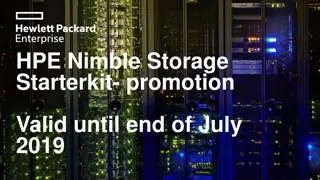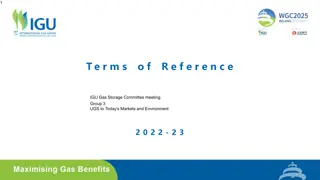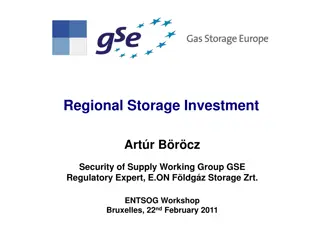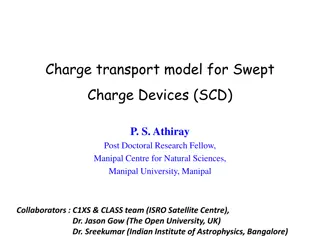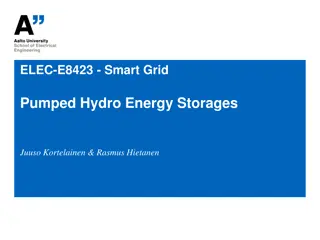Improvements for Energy Storage State of Charge Awareness
Updates made to NPRR1186 prior to the RTC+B project aim at enhancing awareness, accounting, and monitoring of Energy Storage Resources (ESRs). ERCOT reviewed and revised constraints related to Ancillary Service awards for ESRs, considering different scenarios. Changes were also implemented to address State of Charge (SOC) requirements when providing Fast Frequency Response (FFR). The agenda included discussions on ERCOT comments, SOC requirements, telemetering approach, and implementation timeline. Further improvements are being explored to optimize Ancillary Service clearing processes.
Download Presentation

Please find below an Image/Link to download the presentation.
The content on the website is provided AS IS for your information and personal use only. It may not be sold, licensed, or shared on other websites without obtaining consent from the author.If you encounter any issues during the download, it is possible that the publisher has removed the file from their server.
You are allowed to download the files provided on this website for personal or commercial use, subject to the condition that they are used lawfully. All files are the property of their respective owners.
The content on the website is provided AS IS for your information and personal use only. It may not be sold, licensed, or shared on other websites without obtaining consent from the author.
E N D
Presentation Transcript
NPRR1186 IMPROVEMENTS PRIORTOTHE RTC+B PROJECTFOR BETTER ESR STATEOF CHARGE AWARENESS, ACCOUNTING, AND MONITORING DISCUSS 7/31 COMMENTS ERCOT Staff AUGUST 2, 2023
Agenda Discuss the 7/31 ERCOT Comments on NPRR1186 Review additional examples for SOC Requirement Discuss Section 8.1 Edits with Examples Discuss the proposed single model approach for telemetering AS responsibilities with examples. Update on backward compatibility testing Discuss potential implementation timeline for this change. Summary and Next Steps
Summary of 7/31 Comments Paragraph (4) of Section 4.5.1, DAM Clearing Process, and paragraph (1) of Section 6.4.9.2.2, SASM Clearing Process, have been updated to remove the proposed constraint that would limit Ancillary Service awards for Energy Storage Resources (ESRs) based on Ancillary Service duration requirements. In reviewing some examples, ERCOT recognized that the proposed constraint would not apply under all possible scenarios. ERCOT will continue to explore potential solutions to improve the Day-Ahead Market (DAM) and Supplemental Ancillary Services Market (SASM) Ancillary Service clearing process so that the Ancillary Service duration requirements are taken into account. Any identified resolution will be included in a separate NPRR. Paragraph (14) of Section 6.5.5.2, Operational Data Requirements, and paragraph (4) of Section 8.1, QSE and Resource Performance Monitoring, have been updated to provide different State of Charge (SOC) requirements when an ESR is providing Fast Frequency Response (FFR). Paragraph (4) of Section 8.1 has also been updated to include metrics that ERCOT will use to identify instances of non-compliance that must be reported. 3 3
DAM/SASM AS Duration Accounting The originally filed NPRR1186 on 6/22 had contemplated inserting the following constraint in DAM and SASM to aid in ensuring that DAM/SASM AS awards are operationally feasible. However, in reviewing some examples, ERCOT recognized that the proposed constraint would not apply under all possible scenarios. HSL check: Scale ECRS and Non-Spin awards (changes in yellow) ?????+ ????? ?????? ?????+ ?????? ??????? ????? ?????+ ????? ?????+ ??????? ???? ???????? ???? ???? ??????????????? , ??????= ?????= ???????????????? Example 1: For a +/-10 MW, 10 MWh ESR (gen side) that submits a 10 MW AS offer with prices for RegUp, RRS-PFR, ECRS and Non-Spin, (ESR qualified for 10 MW for RegUp, RRS, 5 MW for ECRS, 2.5 MW for Non-Spin) the above constraint will be: ?????+ 2 ?????? ?????+ 4 ??????? ????? ?????+ ????? ?????+ ??????? 10 ???????? If ESR awarded 2.5 MW Non-Spin, then, the above constraints prevent any other product (energy or AS) from being awarded to ensure operational feasibility. Example 2: For a +/-10 MW, 15 MWh ESR (gen side) that submits a 10 MW AS offer with prices for RegUp, RRS-PFR, ECRS and Non-Spin, , (ESR qualified for 10 MW for RegUp, RRS, 7.5 MW for ECRS, 3.75 MW for Non-Spin) the above constraint will be: ?????+ 1.3333 ?????? ?????+ 2.6666 ??????? ????? ?????+ ????? ?????+ ??????? 10 ???????? This constraint does not work for batteries that have a duration that is different than 1 Hour. If RRS and ECRS is in the money , and the best outcome respecting the 15 MWh Max SOC limit is 5 MW RRS award and 5 MW ECRS award, the above constraint does not allow that result. Example if awarded 5 MW of ECRS, the maximum RRS award (based on the above constraint) is 3.3333 MW instead of 5 MW award for RRS. 4 4
SOC Requirement for FFR FFR SOC requirements are equal to ESR s FFR Responsibility multiplied by 0.25 hours. If FFR is deployed, an SOC credit will be given such that the SOC requirement reduces as time elapses since beginning of deployment. After FFR is recalled, for a period of 15min SOC credit is based on the SOC just prior to recall and the ESR s current hour FFR SOC requirement. Beginning 15 minutes after FFR recall, the SOC credit is zero. 2 1 4 3 5
REVIEW FFR & REG DOWN EXAMPLES BRANDT VERMILLION AND JACKSON DUBRO 6 6
REVIEW SECTION 8.1 CHANGE JACKSON DUBRO 7 7
Section 8.1 Edits Update Section 8.1 Paragraph (4) to include metrics that will be used to identify Operating Hours where an ESR has been short in meeting is min/max SOC requirements for the purposes of sharing with Reliability Monitor. 8 8
Thresholds Explanation Minimum SOC Requirement Integrated shortfall for minimum SOC requirement is area between SOC and SOC requirement (grey area) Integrated requirement is the area under the SOC requirement (grey + blue area) Integrated shortfall percentage is equal to the integrated shortfall over the integrated requirement i.e. grey area divided by grey area + blue area 9 9
Example 1: Minimum SOC Violation Not Flagged The ESR started the hour with SOC lower than SOC Requirement. The ESR received charging base points, quickly raising their SOC above the SOC requirement for this hour and ensuring SOC will be greater than the requirement at the start of the next hour 10 10
Example 2: Minimum SOC Violation Not Flagged The ESR started the hour with SOC < SOC Requirement. Moved AS Responsibility to another unit a few minutes into the hour 11 11
Example 3: Minimum SOC Violation flagged by 20% threshold The ESR started the hour with its SOC below the minimum SOC requirement and was consistently low till just prior to 30minutes into the hour. The 20% threshold will flag this scenario. 12 12
Example 5: Minimum SOC Violation flagged by 8MWhh threshold The ESR started the hour with its SOC below the minimum SOC requirement and was consistently low till just prior to 30minutes into the hour. The 8 MWhh threshold will flag this scenario. 13 13
Thresholds Explanation Maximum SOC Requirement Integrated shortfall for maximum SOC requirement is area between SOC and maximum SOC requirement (grey area) Integrated requirement is the area under between the maximum SOC requirement and the maximum state-of-charge of the ESR (grey + blue area) Integrated shortfall percentage is equal to the integrated shortfall over the integrated requirement i.e. grey area divided by grey area + blue area 14 14
Example 6: Maximum SOC Violation Not Flagged The ESR started the hour with SOC greater than the maximum SOC requirement. The ESR discharged at the beginning of the hour, lowering their SOC below the maximum SOC requirement for this hour and ensuring SOC will be lower than the requirement at the start of the next hour. 15 15
Example 7: Maximum SOC Violation flagged by 20% threshold This ESR came into the hour with SOC above requirement and stayed above till just prior to 30min into the hour. The 20% threshold will flag this scenario. 16 16
Example 7: Maximum SOC Violation flagged by 8 MWhh threshold This ESR came into the hour with SOC above requirement and stayed above till just prior to 30min into the hour. The 8MWhh threshold will flag this scenario. 17 17
ESR AS TELEMETRY CHANGE LUIS HINOJOSA 18 18
ESR AS Telemetry Change Not tied to NPRR1186 The current combo model for ESR (combo of ESR-GR and ESR-CLR) has complicated the process of the QSE moving the AS responsibilities on an ESR between its modeled ESR-GR and ESR-CLR to self-manage SOC. In addition, under certain scenarios, an ESR-GR and/or ESR-CLR may incur compliance violations and Base Point Deviation charges even when the overall ESR performance meets expectations. Proposed change in ESR AS telemetry 1. All up AS Responsibilities be carried first on the ESR-GR side of the ESR up till HSL and any remaining up AS Responsibility then be carried on the ESR-CLR side. Similarly, all the Regulation Down Responsibility be carried first on the ESR-CLR side of the ESR up till MPC and any remaining Regulation Down Responsibility then be carried on the ESR-GR side. 2.The telemetered Regulation Up and Regulation Down participation factors are expected to be updated based on Regulation deployment amounts for both ESR-GR and ESR-CLR so that ERCOT can compute expected Regulation deployment from both sides of the ESR. In order to support (2) above changes to ERCOT system are needed to enable this feature. ERCOT has tested that if this feature is enabled the current approach for telemetering AS continues to work. Following slides provide additional details. 19 19
ESR Regulation Adjustment Logic - Recap When this logic is enabled, Regulation Responsibility no longer needs to be moved across the ESR. This will limit the ESR from being locked due to AS. As discussed in the previous workshop, participation factors should be updated to represent which portion of the ESR is providing regulation. Sum of participation factors should equal 1 If participation calculations are wrong, regulation deployment calculations will be incorrect and compliance reporting will be impacted. 20 20
ESR Regulation Adjustment Logic Note 1 When this logic is enabled, QSEs do not need to move the regulation responsibility across the ESR- Gen and ESR-CLR. ERCOT can compute Regulation deployment by using the telemetered regulation participation factors on both the ESR-GR and ESR-CLR. Example below shows telemetry setup using proposed approach. Date-Time 17:05 17:10 17:30 17:35 17:40 17:45 17:50 17:55 GR-RURS 80 80 80 80 80 80 80 80 GR-RUPF 1 1 1 0 0 0 0 0 CLR-RURS 0 0 0 0 0 0 0 0 CLR-RUPF 0 0 0 1 1 1 1 1 21 21
ESR Regulation Adjustment Logic Note 2 When this logic is enabled, QSEs may continue using current approach of transitioning Regulation responsibilities as well. Note that the current approach is vulnerable to false positive compliance violations under certain scenarios. Example below shows telemetry setup using current approach for the same conditions as in previous slide. Note that the only change between the two examples is Regulation Up responsibility telemetry. Date-Time 17:05 17:10 17:30 17:35 17:40 17:45 17:50 17:55 GR-RURS 80 80 0 0 0 0 0 0 GR-RUPF 1 1 1 0 0 0 0 0 CLR-RURS 0 0 80 80 80 80 80 80 CLR-RUPF 0 0 0 1 1 1 1 1 22 22
ESR Regulation Adjustment Logic Note 3 If regulation participation factors are not accurately updated, then regulation deployment will be incorrectly calculated. Example below demonstrates a scenario where an ESR step changes GR-PUPFR from 1 to 0 and CLR-PUPFR from 0 to 1 when responsibility is moved, while the ESR-GR is still injecting. For the highlighted red period where the ESR-GR is still providing MW <> 0, regulation deployment will be inaccurately calculated. 23 23
ESR Regulation Adjustment Logic Note 3 Contd. If regulation participation factors are not accurately updated, then regulation deployment will be incorrectly calculated. Example below demonstrates as scenario, when Reg Up responsibility is moved to ESR-CLR but the ESR-GR s RUPF incorrectly remains at 1. In the past, this would be ignored since the ESR-GR does not have a Regulation Up responsibility. However, when this logic is enabled, the ESR-GR s RUPF will be accounted in regulation deployment that is calculated for the ESR-GR and ESR-CLR. When this logic is enabled, if QSEs chose to operate using current telemetry setup then care should be taken to ensure that when an ESR-GR or ESR-CLR has a zero Regulation Up (or Down) responsibility then the corresponding Participation Factor should equal 0. 24 24
ESR AS Telemetry Change Timeline ERCOT understands that making proposed AS telemetry changes will take more time for some ESR QSEs than others. The testing that ERCOT has done in this regards is helpful as it lets an option be considered where the feature can be enabled before all ESR QSEs are ready. Note that if this option were to be considered, the current transition requirements would continue to apply to those ESRs and QSEs that stay on current approach. This in turn makes operational performance monitoring very tricky both in Real Time and post hoc. Hence to ERCOT an approach like this is a temporary and by a certain date all ESR QSE telemetry should be transitioned to the proposed approach. 25 25
SUMMARY NITIKA MAGO 26 26
NPRR 1186 Summary of Changes with 7/31 Comments Alter Day-Ahead Market (DAM) process so that the Day-Ahead Ancillary Service (AS) awards respect the duration requirements for AS. Absent this change, in some cases DAM AS awards may not be operationally feasible. [Protocol Section: 4.5.1, 6.4.9.2.2] COP will be updated to include 3 new SOC related fields. These fields will be used to supplement the HASL used in RUC such that RUC only counts on SOC that an ESR plans to have in excess of SOC required for AS it is providing in every hour as being available for dispatch. [Protocol Section: 3.9.1, 5.5.2] This change will alleviate some of the risks with RUC s lack of visibility into ESRs. Three new SOC related fields will be added in COP. Post NPRR1186, RUC will continue to treat ESRs as online or Out; RUC will not commit an ESR to come online; RUC will not model ESRs fully; RUC will only count on ESR being available to serve Load if it has SOC in excess of its AS obligation. Change the HASL calculation that is used by 5-min SCED to account for SOC required to support an ESR s Ancillary Service Resource Responsibility. [Protocol Section: 6.5.5.2, 6.5.7.2] This change will ensure that an ESR s Real Time injection HASL will be based on the SOC that the ESR actually has in excess of its SOC requirement. Similarly, an ESRs Real Time charging HASL will be based on the margin the ESR has to charge in excess of the SOC margin required to provide Regulation Down obligation (if any). Post NPRR1186, the HASL changes, will not force an ESR to charge to replenish SOC. The obligation of taking actions such that the ESR stays in compliance with the SOC requirements falls on the QSE. Minimum and maximum SOC requirements that will be used for compliance measurements. [Protocol Section: 8.1] The SOC requirements will take current Operating Hour s AS obligation the ESR is providing on the injection sides into account, the SOC requirement will reduce as time progresses within the hour and will also include a credit if the ESR has an active Base Point in excess of its LASL to charge. 27 27
Review Timeline NPRR1186 continues to be on a fairly tight review timeline with the target of Aug 2023 BoD Meeting. Aug 2, 2023 Workshop Aug 10, 2023 PRS Aug 22, 2023 TAC Aug 31, 2023 BoD Sep 14, 2023 PUC OM Stakeholders are requested to review the NPRRs and reach out with questions/comments to ERCOT as soon as practicable. Please reach out to Nitika Mago (nmago@ercot.com), Kenneth Ragsdale (kragsdale@ercot.com), Sai Moorty (smoorty@ercot.com) or Pamela Shaw (pshaw@ercot.com). 28 28
EXTRAS 29 29
Background & NPRR 1186 Introduction ERCOT has seen a steady growth in the capacity of interconnected battery Energy Storage Resources (ESRs). This rapid growth is expected to continue in the future as well. Most ESRs interconnected or planning to interconnect are less than 2 hours batteries. ESRs are already providing more than 60% of ERCOT s Regulation Up and Responsive Reserve Service Ancillary Services (AS). ERCOT s current systems and processes including DAM, RUC and SCED are not designed to account for capability i.e., State of Charge (SOC) of duration limited ESRs. Also, per the approved protocols, Real-Time Co-optimization (RTC) & Single-Model ESR ( RTC+B effort) systems as planned today will model ESRs but do not model SOC changes. Absent SOC modeling, RUC may incorrectly assume an ESR s capacity will be available for dispatch in a future hour when it may not be (due to SOC depletion). This could result in ERCOT failing to commit sufficient generation through RUC. SCED may send Base Points that may deplete an ESR s SOC that should be preserved for its remaining AS obligation. (ESRs have the ability to reduce HSL/MPC to preserve SOC for AS but that alone may not be sufficient.) Updating current RUC and SCED to model ESRs and account for SOC are expected to be fairly intensive tasks. Hence the changes in NPRR1186 have been proposed with the aim to strategically improve SOC awareness in the current tools and studies with minimal system changes so that a complete suite of DAM, RUC and SCED improvements needed to fully model ESRs and account for their SOC can be designed and implemented with the RTC+B (with single ESR model) project. The minimal changes in RUC and SCED that have been identified in NPRR1186 are essential for ERCOT to continue reliable grid operations. 30 30
What tools does the QSE have to meet SOC requirements What tools does the QSE have to meet min SOC requirements Move some responsibility to another resource Submit a bid (current max Bid is $5,000/MWh) and if non-zero BP is received then charge Reduce HSL move some up AS responsibility to CLR and force SCED to dispatch to honor the LASL What tools does the QSE have to meet max SOC requirements Move some down AS responsibility to another resource Reduce MPC and move some Reg Down to the Gen-side In the event the Gen-HASL is non-zero, submit offer to get an injection Base Point (or increase injection Base Point). 32 32
ESR Regulation Adjustment Logic Example 1 With a more complex example to demonstrate regulation responsibility does not need to be moved across the ESR. Regulation deployment can be calculated by telemetering updated regulation participation factors on both the ESR-GR and ESR-CLR. 33 33
ESR Regulation Adjustment Logic Example 2 Here is a more complex example with the CLR receiving new BPs will carrying regulation and the responsibilities are moved and RUPFs are updated as expected. Note for 17:55 SCED run the QSE can move the regulation to the GR to receive a lower BP on the CLR but can still telemeter CLR-RUPF to represent the active regulation deployment. 34 34
Posted Material Jun 22, 2023 Workshop Link July 19, 2023 Workshop Link Includes Posted August 2, 2023 Workshop Link 35 35



